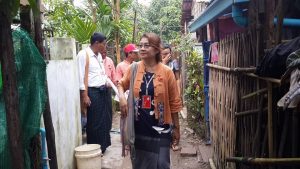2015 Elections Highlight Longstanding Gender Imbalance
By Burma Partnership • September 15, 2015 The Union Election Commission has announced that of the 6,189 candidates that registered for the 2015 elections on 8 November, only 800 are women. Though the number of women involved in Burma’s political scene has improved from the abysmal 3% of female candidates during the 2010 General Elections, this year’s current list of candidates comes nowhere close to solving Burma’s tragic gender imbalance.
The Union Election Commission has announced that of the 6,189 candidates that registered for the 2015 elections on 8 November, only 800 are women. Though the number of women involved in Burma’s political scene has improved from the abysmal 3% of female candidates during the 2010 General Elections, this year’s current list of candidates comes nowhere close to solving Burma’s tragic gender imbalance.
According to UN Women, women currently hold only 4.4% of seats in the Union Parliament. This statistic is even more appalling when comparing Burma to the higher representation of women in parliament amongst its regional neighbors. At the subnational governance level, women occupy less than 3% of the MP and Minister positions at State and Region Parliaments, barely 0.1% of administrator positions at the Village Tract level, and absolutely zero women maintain an administrator role at the Township level. Considering the systemic lack of gender equality in the society, it is no surprise that women are vastly underrepresented in the 2015 elections.
For many women in Burma, opportunities to become involved in politics and find careers working for the Government are severely limited by the overwhelming patriarchy of the Burma Army and their involvement in state affairs. For instance, in the 2008 Constitution there is a stipulation that potential presidential candidates are required to have a “military vision”. As the military is predominately comprised of men, this provision effectively rules out the possibility for a woman to seek the top job.
A report from Article 19 titled “Censored Gender” explores the relationship of gender equality and the Burma Army even further. In the report, the Burma Army is accused of creating a system of governance in which woman are defined as, “vulnerable mothers needing protection rather than a voice, and certainly not people who need positive measures to promote their voice in governance.”
Other barriers preventing women from becoming involved in politics include the effect of traditional Buddhist beliefs on the role of women in society, the failure of the 2008 Constitution to prevent discrimination against women and promote gender equality, and the lack of access to training and prerequisite experience for high-level jobs. These factors contribute to an institutionalization of discrimination against women that prevent them from having their voices properly heard.
In recent times, institutionalized discrimination against women has manifested itself in the creation of the Race & Religion Protection Bills. One of the new acts, a birth-spacing law that will likely be used to limit the growth of ethnic and religious minority groups, threatens to severely undermine women’s reproductive rights. Another discriminatory bill will regulate marriages between Buddhist women and those outside of their faith, allowing the state to prevent the right of a woman to choose whom she marries. Spearheaded by the discriminatory fervor of the ultranationalist Ma Ba Tha (National Association for Race and Religion Protection) organization, these bills spent very little time being debated in parliament and have received condemnation from progressive rights-based civil society groups and the international community.
On the issue of sexual violence against women, the Women’s League of Burma has regularly documented the systematic use of sexual violence, rape and gang rape by the Burma Army, most notably in ethnic conflict areas. While these incidents continue unabated – as members of the Burma Army face little in the way of justice for these crimes – the importance of female representation in Burma’s politics could not be overstated. Without proper representation in Parliament and throughout the Burma Government, voices detailing crimes against women and institutionalized discrimination will remain unheard of.
As a party to the Convention on the Elimination of All Forms of Discrimination against Women, the Burma Government must adopt an effective policy to improve the opportunities for women in politics. Whether through the use of a quota system and/or by identifying and removing the institutionalized discrimination against women, the Burma Government must demonstrate that it is working towards promoting gender equality in all sectors of society and government so as to fulfill its international obligations. Especially in this very important time of carrying out reforms, the 2015 elections create a unique opportunity to promote gender equality in the country’s political sphere. However, in the current context of the upcoming 2015 elections, this opportunity will most likely be missed and women will continue to go underrepresented.
Tags: 2008 Constitution, 2015 Elections, ASEAN, Burma Partnership, Convention on the Elimination of All Forms of Discrimination against Women, National Association for Race and Religion Protection, the Race & Religion Protection Bills, WomenThis post is in: 2015 Burma Elections, Blog
Related PostsMyanmar: Release Four “Rohingya Calendar” Political Prisoners
Burma: Rights Priorities for New Government
Myanmar: Scrap or Amend new Law that could Grant Immunity to Former Presidents
Burma Army Moves to Tighten Grip on Power
Sounds of War Taint the Cheers of Election Success









 All posts
All posts